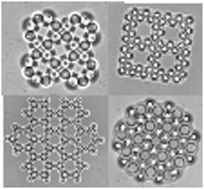Two-dimensional assemblies of nematic colloids in homeotropic cells and their response to electric fields
Abstract
Micrometer-sized colloidal particles dispersed in nematic liquid crystals interact with each other through anisotropic interactions induced by orientational deformation of the nematic field. In the case of so-called dipole nematic colloids, their interaction is of the dipole–dipole type. Two-dimensional, non-close-packed colloidal assemblies having various characteristics were fabricated using optical tweezers by exploiting the attraction between anti-parallel dipole nematic colloids in homeotropically aligned nematic cells. Structures comprising polygons, squares, and tetrahedra were built using equal-sized particles, and hexagonal structures were built using particles of two sizes. As the nematic field is sensitive to electric fields, the response of the fabricated assemblies toward an alternating electric field was also studied. All assemblies exhibited homogeneous reversible shrinkage, and their shrinkage rates were dependent on the structure. The maximum shrinkage rate in the linear dimension of the assemblies was over 20% at 5 Vrms for a hexagon comprising tetrahedral units.


 Please wait while we load your content...
Please wait while we load your content...